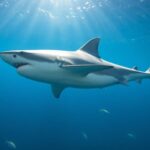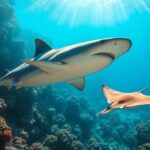If you’re planning a trip to Puerto Rico, you might be wondering about the marine life lurking beneath the waves. Are there sharks in Puerto Rico? The answer is yes! Puerto Rico’s warm waters are home to various shark species, including nurse sharks, reef sharks, and even the occasional hammerhead.
Overview of Sharks in Puerto Rico
Sharks inhabit the warm waters surrounding Puerto Rico, contributing to its vibrant marine ecosystem. You can encounter various shark species, each playing a crucial role in the health of these waters.
Common Shark Species
| Shark Species | Description | Habitat |
|---|---|---|
| Nurse Shark | Generally docile, they often rest on the ocean floor during the day. | Coral reefs, rocky areas, lagoons |
| Blacktip Reef Shark | Known for their agility and distinctive black tips on their fins. | Shallow waters near coral reefs |
| Hammerhead Shark | Distinguished by their unique head shape, these sharks occasionally visit shallower waters near Puerto Rico. | Off shallow waters, mainly around deep reefs |
Shark Behavior and Risks
Sharks in Puerto Rico exhibit varied behaviors. You may find nurse sharks resting on the ocean floor, while blacktip reef sharks are more active, swimming in schools. Hammerhead sightings occur during specific seasons, often near deeper waters.
The risk of shark attacks in Puerto Rico remains minimal. According to the Shark Attack File by the International Shark Attack File (ISAF), no fatalities occurred in Puerto Rico from 1837 to 2021. When swimming or snorkeling, observe these tips to reduce risks:
- Avoid swimming in murky water.
- Don’t wear shiny jewelry.
- Stay in groups when swimming.
Conservation Efforts
Efforts to protect shark populations in Puerto Rico are essential. Local organizations work to educate the public and promote sustainable fishing practices. The marine ecosystem benefits from the balance that sharks maintain.
Puerto Rico’s waters host a variety of shark species, contributing to the aquatic landscape. Understanding their behavior, risks, and the need for conservation enhances your appreciation of these majestic creatures.
Common Shark Species Found
Puerto Rico’s waters host several shark species, each contributing to the vibrant marine ecosystem. Here are some of the most common species you may encounter.
Atlantic Sharpnose Shark
The Atlantic sharpnose shark is a small species that typically grows up to 3.5 feet long. This shark features a slender body and is easily identifiable by its pointed snout. Characteristics include:
| Feature | Description |
|---|---|
| Size | Up to 3.5 feet |
| Coloration | Grayish-brown with light spots |
| Habitat | Shallow coastal waters |
| Behavior | Active during the day |
Atlantic sharpnose sharks primarily feed on small fish and invertebrates. Their presence in Puerto Rico’s waters adds diversity to the marine life.
Nurse Shark
Nurse sharks, known for their docile nature, can reach lengths of up to 14 feet. They prefer to rest on the ocean floor during the day and often inhabit coral reefs and sandy bottoms. Key details include:
| Feature | Description |
|---|---|
| Size | Up to 14 feet |
| Coloration | Yellow-brown with darker spots |
| Habitat | Coral reefs and sandy bottoms |
| Behavior | Relatively inactive, nocturnal feeder |
With their calm demeanor, nurse sharks pose minimal threat to humans, making encounters safe and fascinating.
Caribbean Reef Shark
Caribbean reef sharks are larger, reaching lengths of up to 10 feet. They display agility and a sleek design, thriving in shallow waters. Important aspects are:
| Feature | Description |
|---|---|
| Size | Up to 10 feet |
| Coloration | Gray body with a white underside |
| Habitat | Coral reefs and deep waters |
| Behavior | Solitary or in small schools |
These sharks play an essential role in maintaining the health of reef ecosystems by regulating fish populations.
Shark Behavior and Habitats
Sharks in Puerto Rico exhibit distinct behaviors and occupy various habitats. Understanding their feeding habits and breeding grounds enhances your knowledge of these fascinating creatures.
Feeding Habits
Sharks in Puerto Rico demonstrate diverse feeding strategies based on their species.
| Species | Eating Behavior | Primary Diet | Activity Level |
|---|---|---|---|
| Nurse Shark | Generally inactive, often resting | Small fish, crustaceans | Low |
| Blacktip Reef Shark | Active, often hunts in schools | Fish, squid | Moderate to High |
| Hammerhead Shark | Solitary or in schools | Fish, including stingrays | High |
| Atlantic Sharpnose Shark | Daytime feeding | Small fish, invertebrates | High |
| Caribbean Reef Shark | Opportunistic predator | Various fish, including groupers | Moderate to High |
The behavior often correlates with the time of day, with some species active during daylight, while others prefer twilight or nocturnal feeding.
Breeding Grounds
Shark breeding grounds in Puerto Rico play a crucial role in maintaining healthy populations.
| Species | Preferred Breeding Locations | Characteristics of Breeding Grounds |
|---|---|---|
| Nurse Shark | Shallow coastal waters | Sandy bottoms, often near reefs |
| Blacktip Reef Shark | Reef areas, lagoons | Sheltered environments, conducive to young |
| Hammerhead Shark | Open waters near continental shelf | Warm waters, often near the surface |
| Atlantic Sharpnose Shark | Estuaries, coastal shallows | Brackish waters, rich in nutrients |
| Caribbean Reef Shark | Coral reef areas | Abundant prey, ample hiding spots |
Seasonal migrations to specific breeding areas ensure the survival of young sharks. Understanding these patterns provides insight into conservation efforts aimed at protecting shark populations.
Safety Tips for Swimmers
Understanding shark behavior and taking precautions enhances your safety while swimming in Puerto Rico’s waters. Subscribers to these tips will enjoy a more secure experience.
Shark Sightings and Precautions
Monitor local reports on shark sightings before heading to the beach. Swim with a buddy and stay in designated swimming areas. Avoid swimming during dawn and dusk when sharks are more active.
| Precautionary Measure | Description |
|---|---|
| Swim with a buddy | Staying together reduces risk and increases safety. |
| Avoid shiny jewelry | Shiny objects may resemble fish scales, attracting sharks. |
| Stay in groups | Larger groups are less likely to attract sharks. |
| Don’t swim near schools of fish | Schools can indicate the presence of predators. |
What to Do If You Encounter a Shark
Stay calm if a shark approaches. Maintain eye contact and back away slowly. Avoid splashing, as sudden movements may attract its attention. If a shark appears aggressive, respond assertively by hitting its nose, eyes, or gills.
| Action | Description |
|---|---|
| Remain calm | Panic increases the risk of an aggressive response. |
| Back away slowly | Avoid sudden movements to reduce agitation. |
| Hit vulnerable spots | Striking the nose or eyes can deter a shark. |
Adhering to these guidelines minimizes risks and enhances your enjoyment of the ocean.
Conclusion
Sharks are a natural part of Puerto Rico’s vibrant marine ecosystem. While various species inhabit these waters you can feel confident knowing that the risk of shark encounters is low. By following safety tips and being aware of your surroundings you can enjoy the beauty of the ocean without worry.
Understanding these majestic creatures helps foster a greater appreciation for their role in maintaining healthy reefs. So next time you’re swimming in Puerto Rico keep in mind the fascinating world beneath the surface and the importance of protecting these incredible species.
Frequently Asked Questions
What shark species can be found in Puerto Rico’s waters?
Puerto Rico is home to various shark species, including nurse sharks, blacktip reef sharks, hammerhead sharks, Atlantic sharpnose sharks, and Caribbean reef sharks. Each species inhabits different areas and exhibits unique behaviors, contributing to the marine ecosystem’s diversity.
Are nurse sharks dangerous to humans?
Nurse sharks are generally docile and not considered a threat to humans. They often rest on the ocean floor and display non-aggressive behavior. However, like any wild animal, it’s best to observe them from a safe distance.
How often do shark attacks happen in Puerto Rico?
Shark attacks in Puerto Rico are extremely rare, with no fatalities reported from 1837 to 2021. Swimmers can safely enjoy the waters by following safety tips and staying aware of their environment.
What are some safety tips for swimming in areas with sharks?
To enhance safety while swimming in shark-inhabited waters, monitor local shark reports, swim with a buddy, avoid early morning and late evening swims, and stay away from schools of fish. If approached by a shark, remain calm and back away slowly.
What is the importance of sharks in marine ecosystems?
Sharks play a vital role in maintaining healthy marine ecosystems by regulating fish populations and ensuring biodiversity. They help control the balance of prey species and contribute to the overall health of coral reefs and other habitats.

I am a passionate explorer of the deep sea, endlessly fascinated by the mysteries that lie beneath the ocean’s surface. From the graceful glide of a manta ray to the powerful presence of a great white shark, I find inspiration in every creature that calls the sea its home. My love for marine life began at an early age and has grown into a lifelong mission to study, understand, and share the wonders of our blue planet. Through Planet Shark Divers, I combine my enthusiasm for sharks and other sea animals with a dedication to education and conservation. Each article is crafted to unravel myths, reveal fascinating facts, and inspire respect for the extraordinary life forms that thrive in the depths. Whether it’s the biology of a hammerhead or the mystery of the deep abyss, my goal is to bring the ocean closer to everyone’s heart and mind.


